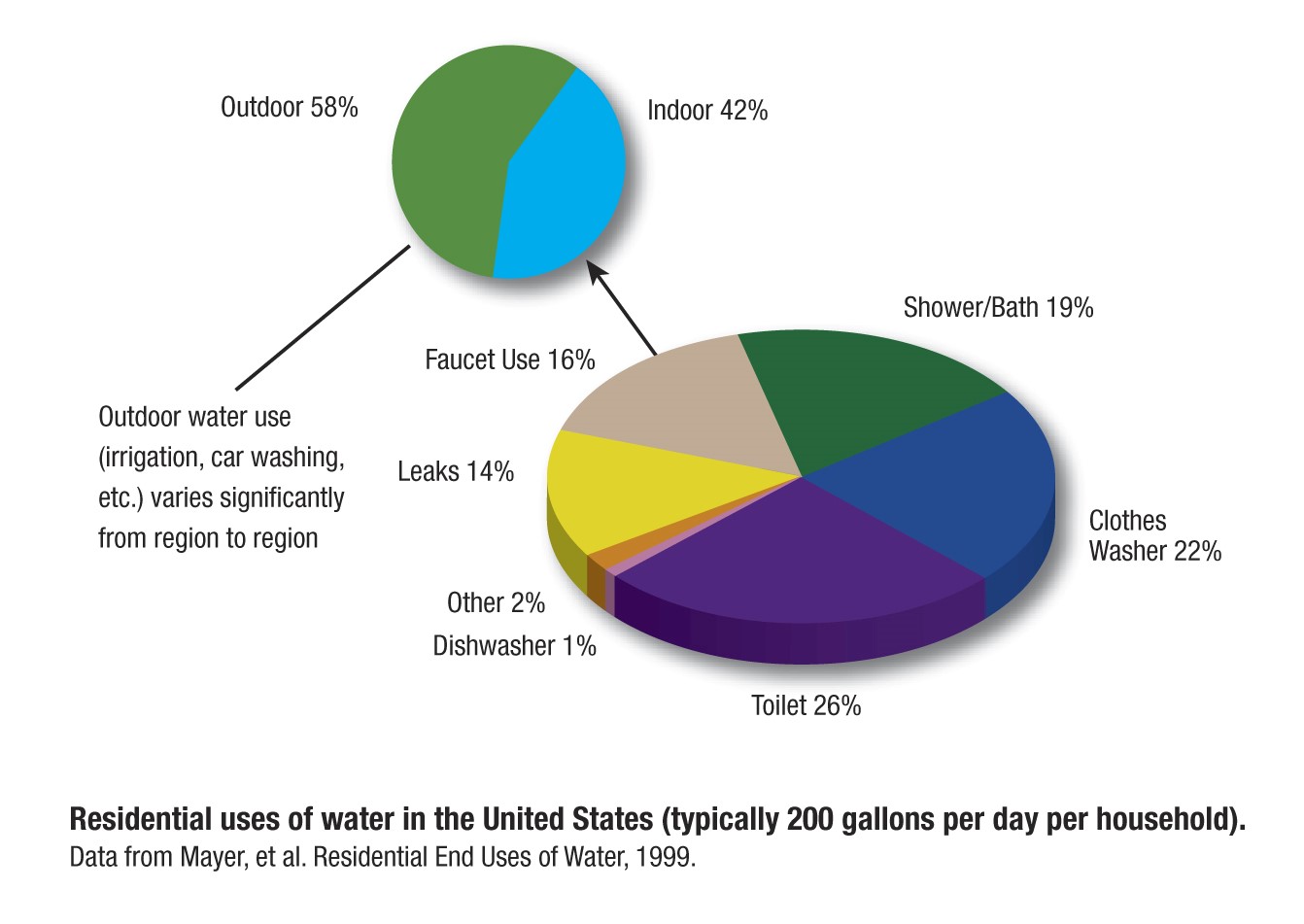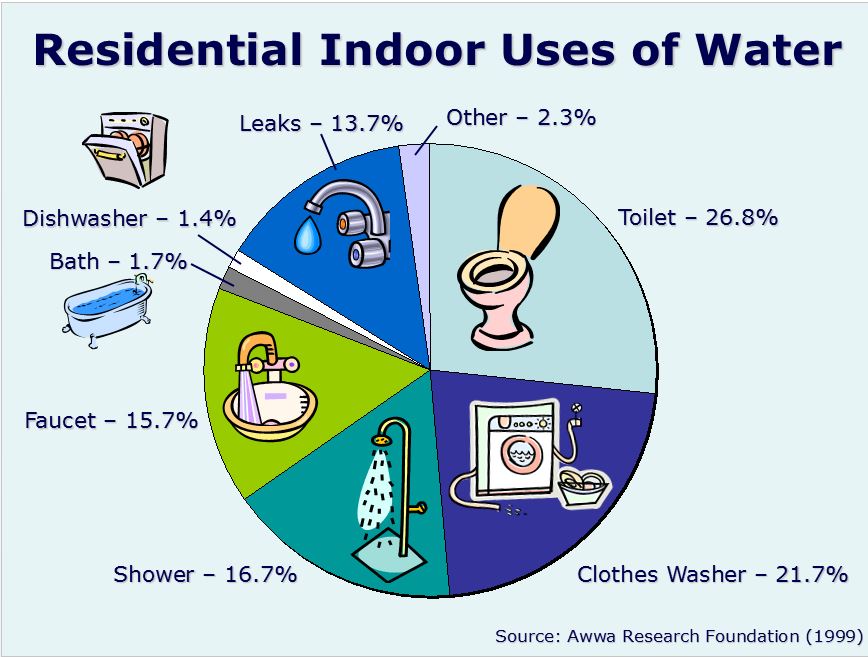Water Savings Guide
OUTDOORS
Did You Know?
In the summer, average residential water use is approximately 5 times higher than in the winter; mainly due to landscape irrigation. The chart below shows the breakdown of water used outdoors.

Watering Wisely
- Water landscaping only when needed. As a general rule, lawns only need watering 3-5 days a week in the summer and shrubs even less. Daily watering may only be necessary when temperatures reach over 100 degrees.
- Water between sunset and sunrise when temperatures and wind are the lowest. Watering during the middle of the day can result in a 30% increase in required water due to evaporation and wind.
- Step on the grass; if it springs back up when you move your foot, it does not need water.
- Avoid over-fertilizing your lawn. Applying fertilizer increases the need for water.
- Group plants with similar watering needs in the same areas.
- Try breaking watering times into two or more shorter cycles, with about an hour resting time in between. This will reduce run-off and increase the amount of water soaking into the ground.
- Check out the City of Ashland’s website for conservation program information and print out a sample watering schedule for our area.
- You can also find more information on current watering needs by calling our Watering Hotline at 541-552-2057.
Sprinkler Care
- Adjust sprinklers to avoid watering sidewalks and driveways.
- Be sure to fix all leaks promptly no matter how small they may seem. Even a small leak can waste hundreds of gallons of water.
- Give your sprinkler system an occasional checkup. If you haven’t observed your system operating lately, turn it on and make sure sprinklers are all facing the right direction and functioning properly.
Yard Maintenance
- Mulching and adding compost to soil can help soil absorb and store water, minimize evaporation, reduce erosion and help control weeds.
- Use a broom instead of a hose to clean your driveway or sidewalk. A hose can use 100 gallons in 10 minutes.
- Raise your lawn mower level to 3 inches. This encourages grass roots to grow deeper, shades the root system and holds soil moisture better than a closely clipped lawn.
- Keep your lawn mower blades sharpened. Dull blades tear grass, forcing it to use more water.
Car Washing
- Consider using a commercial car wash that recycles water.
- If you use a hose to wash your car, be sure to use a hose nozzle that turns the water off when you are not using it. Washing a car for 10 minutes can easily use 100 gallons of water if you let the water run the entire time.
- Wash with a bucket of water and use the hose only for quick rinses.
- Wash items such as bicycles and trash cans on the lawn to prevent the water from running down the storm drain.
INDOORS
Did You Know?
The average single family residential customer in Ashland uses around 5,000 gallons (668 cubic feet) of water per month indoors. Homes with 1 to 2 residents often use even less. The chart below shows the typical breakdown of water used in the home.(1 cu.ft. = 7.48 gal)

In the Kitchen
- Your dishwasher uses the same amount of water whether it is full or not, so wait until it’s full to run it. Consider replacing your old dishwasher with an Energy Star® model to save even more water, and energy too.
- Keep a container of drinking water in the refrigerator, instead of letting the faucet run until the water cools down.
- Avoid letting the water run when rinsing vegetables, cleaning dishes or to defrost food.
- Fix leaks promptly! Even a small faucet drip can waste 20 gallons of water each day. Large leaks can waste hundreds of gallons per day.
In the Laundry Room
- Wait until you have full loads of laundry to run your washing machines. Otherwise, just adjust the water level to fit the size of the load.
- Replace old washing machines with efficient Energy Star models, which can use 40 - 75%, less water and energy than older machines.
In the Bathroom
Toilet
- Replace an old toilet with water efficient WaterSense® labeled models and use 20-75% less water each time you flush.
- For water savings with an existing toilet, install early-closing flappers or place small containers filled with water inside the tank to displace the existing water.
- Toilet leaks are common and can easily be repaired with inexpensive replacement parts.
- Check for toilet leaks by adding about 10 drops of food coloring to the tank. If the toilet is leaking, color will appear in the bowl within 15 - 20 minutes.
- Avoid using the toilet as a wastebasket.
Shower
- Replacing a shower head can be easy and relatively inexpensive. Today’s standard models use 25-50% less water than older models. WaterSense models can save even more, while also being certified to perform well.
- Taking shorter showers can save many gallons of water. A bath can use more or less than a shower depending on how high it is filled.
Faucets
- Changing an aerator is both simple and very low cost. Look for WaterSense aerators that flow 0.5 to 1 gallon per minute for bathroom faucets. These function well while using half as much water as current standard faucets and up to 80% less than older faucets. If the faucet currently has no aerator at all, savings from adding one will be even more.
- Avoid letting the water run while brushing your teeth or shaving.

Many products are now WaterSense certified. Look for WaterSense labels to help you identify products that meet high water efficiency standards and perform well too.
| WATER SAVINGS GUIDE 4.16.13.PDF (273.6kb) |
Online City Services
UTILITIES-Connect/Disconnect,
Pay your bill & more
Pay your bill & more
Connect to
Ashland Fiber Network
Ashland Fiber Network
Request Conservation
Evaluation
Evaluation
Proposals, Bids
& Notifications
& Notifications
Request Building
Inspection
Inspection
Building Permit
Applications
Applications
Apply for Other
Permits & Licenses
Permits & Licenses
Register for
Recreation Programs
Recreation Programs